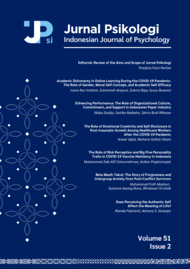Psikologi Peluang Kewirausahaan: Proses Kognitif Pengusaha Startup Digital dalam Opportunity Recognition
Sadida Fatin Aruni(1*), Rahmat Hidayat(2)
(1) Fakultas Psikologi UGM
(2) Fakultas Psikologi UGM
(*) Corresponding Author
Abstract
Keywords
Full Text:
PDFReferences
Acs, Z., & Audretsch, D. (2005). Handbook of entrepreneurship research: An interdisciplinary survey and introduction. New York: Springer Science+Bussines Media, Inc.
Amalia, E. I. (2016, Juni 12). Di Asia Tenggara, Indonesia punya startup paling banyak. Dipetik Oktober 25, 2016, dari MetroTvNews.com: http://teknologi.metrotvnews.com/news-teknologi/9K5G0Dlb-di-asia-tenggara-indonesia-punya-startup-paling-banyak
Baron, R. (1998). Cognitive mechanisms entreprenuership: Why and when entrepreneurs think differently than other people. Journal of Business Venturing, 13(4), 275- 294.
Baron, R. (2004). The cognitive perspective: A valuable tool for answering entrepreneurship’s basic ‘‘why’’ questions. Journal of Business Venturing, 19(2), 221-239.
Baron, R. (2006). Opportunity recognition as pattern recognition: How entrepreneurs “connect the dots” to identify new business oportunities. Academy of Management Perspectives, 20(1), 104 - 119. doi: 10.5465/amp.2006.19873412
Buchari, A. (2009). Manajemen pemasaran dan pemasaran jasa. Bandung: Alfabeta.
Busenitz, L., & Barney, J. (1997). Differences between entrepreneurs and managers in large organizations: Biases and heuristics in strategic decision-making. Journal of Business Venturing, 12(1), 9-30.
Dahl, D. W., & Moreau, C. P. (2002). The influence and value of analogical thinking during new product ideation. Journal Marketing Res, 39(1), 47-60. doi: 10. 1509/ jmkr.39.1.47.18930
Drucker, P. (1985). Innovation and entrepreneurship. New York: Harper & Row.
Dunbar, K. (1993). Concept discovery in a scientific domain. Cognitive Science, 17(3), 397-434. doi: 10.1207/s15516709cog1703_3
Gaglio, C. M., & Katz, J. (2001). The psychological basis of opportunity identification: entrepreneurial alertness. Small Business Economics, 16(2), 95-111.
Gartner, W. (1989). "Who is an Entrepreneur?" is the wrong question. Entrepreneurship Theory and Practice, 14(1), 47-66.
Geldhof, G., Malin, H., Johnson, S., Porter, T., Bronk, K., Weiner, M., . . . Damon, W. (2014). Entrepreneurship In young adults: Initial findings from the young entreprenuers study. Journal of Development Psychology, 35(5), 410 - 421. doi: 10. 1016/j.appdev.2014.07.003
Gentner, D. (1983). Structure-mapping: A theoretical framework for analogy. Cognitive Science, 7(2), 155-170.
Gentner, D. (1989). The mechanisms of analogical learning. In S. Vosniadou, & A. Ortony, Similarity and Analogical Reasoning (pp. 199-241). Cambridge: Cambridge University Press.
Gentner, D., Rattermann, M. J., & Forbus, K. D. (1993). The roles of similarity in transfer: Separating retrievability from inferential soundness. Cognitive Pscyhology, 25(4), 524-575.
Gentner, D., Rattermann, M. J., Markman, A. B., & Kotovsky, L. (1995). Two forces in the development of relational similarity. In T. J. Simon, & G. S. Halford, Developing cognitive competence: New approaches to process modeling (pp. 263-313). Hilsdale, NJ: Lawrence Erlbaum Associates.
George, N., Parida, V., Lahti, T., & Wincent, J. (2016). A systematic literature review of entrepreneurial opportunity recognition: Insights on influencing factors. International Entreprenurship Management Journal, 309 - 350. doi: 10.1007/s11365-014-0347-y
Gregoire, D., Barr, P., & Shepherd, D. (2010). Cognitive processes of oppportunity recognition: The role of structural alignment. Organization Science, 21(2), 413 - 431. doi: 10.1287/orsc.1090.0462
Hahn, U., & Chater, N. (1997). Concepts and similarity. In K. Lamberts, & D. Shanks, Knowledge, concepts, and categories (pp. 43-92). Cambridge: MIT: Press.
Hayes, N. (2000). Doing psychological research. Buckingham: Open University Press.
Holland, J., Holyoak, K. J., Nisbett, R. E., & Thagard, P. (1986). Induction: Processes of inference, learning, and discovery. Bradford: MIT Press Cambridge.
Holyoak, K. J. (1985). The pragmatics of analogical transfer. In G. H. Bower, The psychology of learning and motivation (pp. 59-87). New York: Academic Press.
Khilstrom, R., & Laffont, J. (1979). A general equilibrium entrepreneurial theory of firm formation based on risk aversion. Journal of Politic and Economy, 87(4), 719-748.
Kominfo.go.id. (2016, Juni 17). Kominfo luncurkan gerakan nasional 1000 startup digital. Dipetik Oktober 26, 2016, dari Kominfo.go.id: https://www.kominfo.go.id/content/detail/7689/kemkominfo-bersama-kibar-luncurkan-gerakan-nasional-1000-startup-digital/0/berita_satker
Krueger, N. (2003). The cognitive psychology of entrepreneurship. In Z. Acs, & D. Audretsch, Handbook of entreprenurship research (pp. 105 - 140). Great Britain: Kluwer Academic Publisher.
Matlin, M. W. (2008). Cognition. Hoboken, New Jersey: John Wiley & Sons.
Pradana, R. S. (2013, Februari 04). Wirausaha: Indonesia butuh 4,8 juta pengusaha pemula. Dipetik Oktober 2016, 2016, dari Bisnis.com: http://entrepreneur.bisnis.com/read/20130204/88/134728/wirausaha-indonesia-butuh-4-8-juta-pengusaha-pemula
Ryza, P. (2016, September 30). Peran aktif pemerintah Indonesia dukung industri startup dan ekonomi digital. Retrieved Oktober 25, 2016, from Dailysocial.id: https://dailysocial.id/post/peran-aktif-pemerintah-indonesia-dukung-industri-startup-dan-ekonomi-digital
Sawitri, A. A. (2016, Mei 04). BPS: Pengangguran terbuka di Indonesia capai 7,02 juta orang. Dipetik Oktober 25, 2016, dari Tempo.com: https://m.tempo.co/read/news/2016/05/04/173768481/bps-pengangguran-terbuka-di-indonesia-capai-7-02-juta-orang
Shane, S. (2000). Prior knowledge and the discovery of entrepreneurial opportunities. Organization Science, 11(4), 448 -469.
Shane, S. (2003). A general theory of entrepreneurship: The individual-opportunity nexus. Cheltenham: Edward Elgar.
Shaver, K., & Scott, L. (1991). Person, process, choice: The psychology of new venture creation. Entrepreneurship Theory and Practice, 2(2), 23 - 45. doi: 10.1177/ 104225879201600204
Someran, M. W., Barnard, Y., & Sandberg, J. A. (1994). The think aloud method : A practical guide to modelling cognitive processes. London: Academic Press.
U.S Small Business Administration. (2016). Startups & high growth businesses. Diunduh Oktober 26, 2016, dari Small Bussines Administration: https://www.sba.gov/starting-business/how-start-business/business-types/startups-high-growth-businesses
Venkataraman, S. (1997). The distinctive domain of entrepreneurship research. Advances in Entrepreneurship, Firm Emergence and Growth, 3(1), 119 - 138.
Vosniadou, S. A., & Ortony, A. (1989). Similarity and analogical reasoning. Cambridge: Cambridge University Press.
Ward, T. B. (1995). What’s old about new ideas? In S. M. Smith, T. B. Ward, & A. Finke, The creative cognition approach (pp. 157-178). Cambridge: MIT Press.
Whittlesea, B. (1997). The representation of general and particular knowledge. In K. Lamberts, Knowledge, concepts and categories (pp. 211-264). Cambridge: MIT Press.
Article Metrics
Refbacks
- There are currently no refbacks.
Copyright (c) 2019 Jurnal Psikologi

This work is licensed under a Creative Commons Attribution-ShareAlike 4.0 International License.
Recent Issues
 |  |  |  | ||||
| Vol 51 Issue 2 (2024) Page 120-230 | Vol 51 Issue 1 (2024) Page 1-119 | Vol 50 Issue 3 (2023) Page 219-332 | Vol 50 Issue 2 (2023) Page 125-218 |
| Published by Faculty of Psychology, Universitas Gadjah Mada, Indonesia Building D-6th, Floor No. D-606. Jl. Sosio Humaniora No. 1, Bulaksumur Yogyakarta, 55281 Email: jurnalpsikologi@ugm.ac.id Phone/whatsApp: +6281125210175 |











